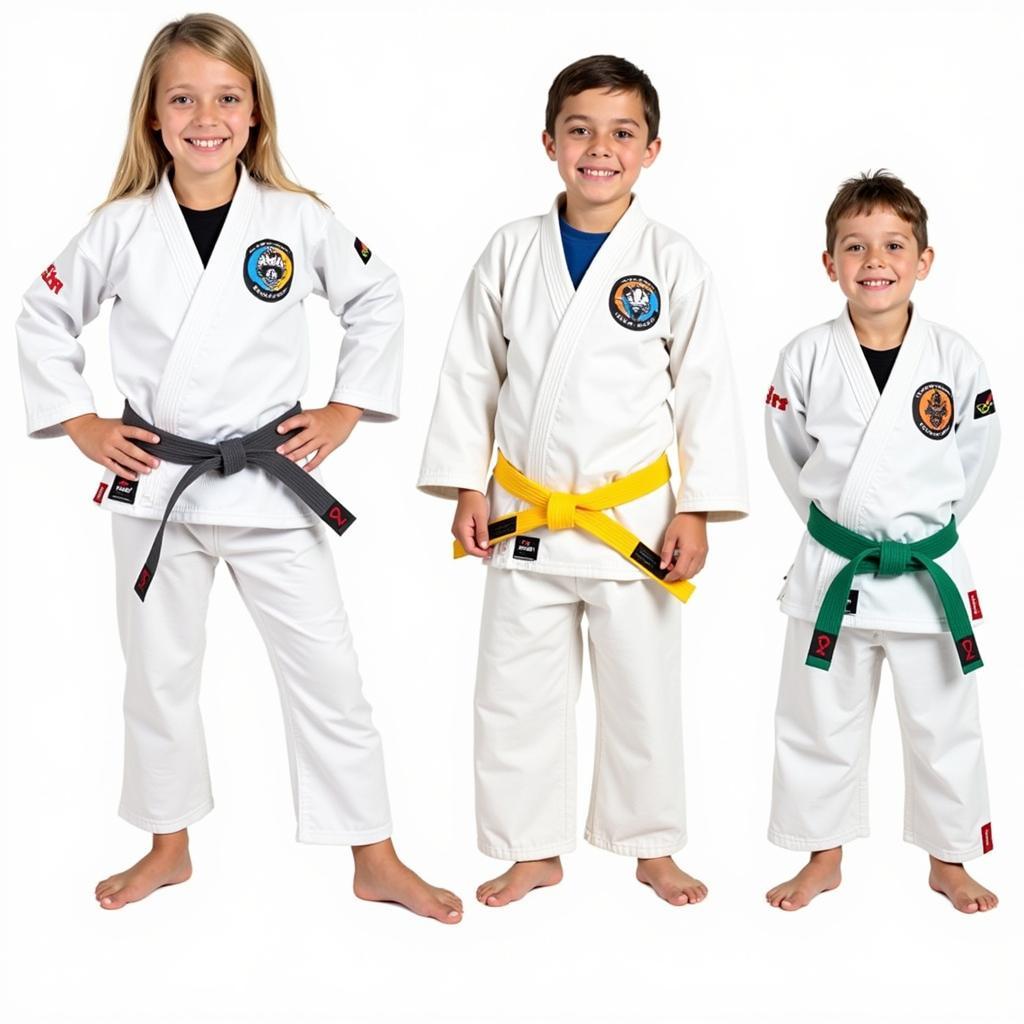Jiu Jitsu, a grappling-based martial art, uses a colored belt system to denote rank and skill progression. Understanding what are the belt colors in jiu jitsu is essential for anyone starting their journey in this challenging and rewarding discipline. The belts represent not just technical proficiency, but also a journey of personal growth, discipline, and dedication.
Understanding the Jiu Jitsu Belt Ranking System
The jiu jitsu belt system provides a visual representation of a practitioner’s journey, marking milestones and motivating continued learning. It’s more than just a fashion statement; each belt signifies a deeper understanding of the art, increased technical ability, and a commitment to the jiu jitsu lifestyle.
Adult Belt Colors in Jiu Jitsu
The standard adult belt progression in most jiu jitsu schools follows this order:
- White Belt: The beginning rank for all new students. It represents the foundation upon which all future learning is built. White belts focus on basic movements, positions, and fundamental submissions.
- Blue Belt: The first colored belt, signifying a solid understanding of the fundamentals and the ability to apply them in live rolling. Blue belts begin to develop their own game and explore more advanced techniques.
- Purple Belt: A significant milestone, representing a deep understanding of jiu jitsu principles and a refined technical skillset. Purple belts are often seen as mentors to lower belts and are expected to exhibit strong leadership qualities.
- Brown Belt: A highly respected rank, signifying mastery of fundamental and advanced techniques. Brown belts are known for their technical proficiency, strategic thinking, and ability to adapt their game.
- Black Belt: The pinnacle of achievement in jiu jitsu, representing years of dedicated training, technical mastery, and a deep understanding of the art. Black belts are considered experts and are often instructors and leaders within the jiu jitsu community.
Kids’ Belt Colors in Jiu Jitsu
Children’s belt rankings in jiu jitsu often include additional colored stripes on each belt to mark smaller increments of progress. This system encourages children and helps them visualize their development. While the exact colors may vary slightly between organizations, a common progression is:
- White Belt
- Grey Belt (with white stripe, then grey stripe)
- Yellow Belt (with white stripe, then yellow stripe)
- Orange Belt (with white stripe, then orange stripe)
- Green Belt (with white stripe, then green stripe)
 Kids' Jiu Jitsu Belt Colors and Stripe System
Kids' Jiu Jitsu Belt Colors and Stripe System
How Long Does It Take to Earn Each Belt?
There is no fixed timeframe for earning each belt. Progression depends on factors such as training frequency, natural aptitude, and individual learning styles. Consistency is key, and some practitioners might progress faster than others.
“Dedication and consistent training are far more important than natural talent when it comes to progressing in jiu jitsu,” says Master Carlos Machado, a renowned 8th-degree red and black belt.
What Does Each Belt Represent Beyond Technique?
Earning a new belt in jiu jitsu symbolizes more than just technical skill. It signifies personal growth, increased discipline, and a deeper understanding of oneself. Each belt represents a stage in the journey of self-improvement.
“Jiu Jitsu is a journey of self-discovery. Each belt you earn is a testament to your perseverance and dedication, both on and off the mat,” explains Professor Rickson Gracie, a legendary figure in the world of jiu jitsu.
Conclusion
Understanding what are the belt colors in jiu jitsu provides a framework for understanding the progression and ranking system within this complex and rewarding martial art. Remember, the journey through the belts is a process of continuous learning, growth, and self-improvement. So, embrace the challenge, and enjoy the journey!
FAQ
- What is the first belt in jiu jitsu? The white belt is the starting rank for all beginners.
- What is the highest belt in jiu jitsu? The red belt is the highest attainable rank, typically awarded to highly respected and accomplished practitioners after decades of dedication.
- Can I skip a belt in jiu jitsu? Belt promotions are solely at the discretion of the instructor and are based on demonstrated skill and understanding, not time served. While extremely rare, skipping a belt is theoretically possible.
- Do all jiu jitsu organizations use the same belt system? While the general structure is similar, minor variations in belt colors and stripes may exist between different jiu jitsu organizations, particularly at the children’s level.
- What should I focus on as a white belt? Focus on mastering the fundamental movements, positions, and escapes.
- How often should I train to progress through the belts? Consistent training is key. Aim for at least 2-3 sessions per week.
- What is the significance of the black belt? The black belt represents technical mastery, leadership, and a deep understanding of the art of jiu jitsu.
Need More Help?
Contact us at Phone: 0373298888, Email: [email protected] or visit us at 86 Cau Giay, Hanoi. We have a 24/7 customer support team.

